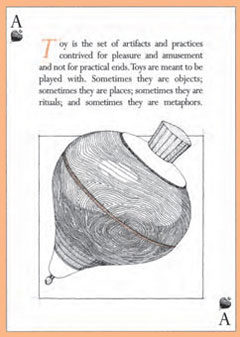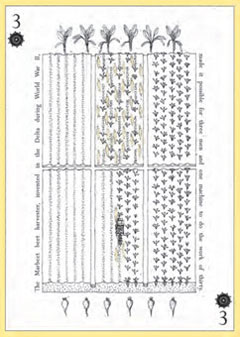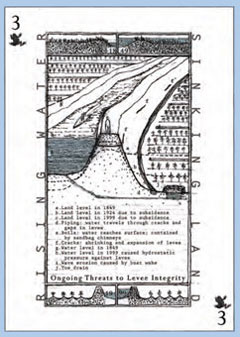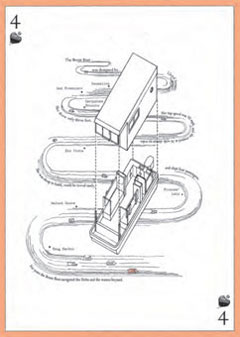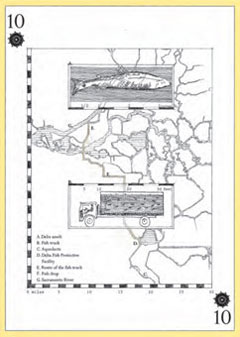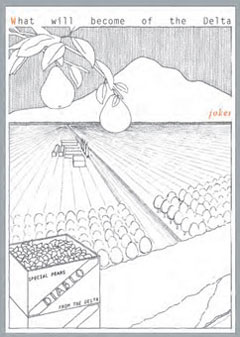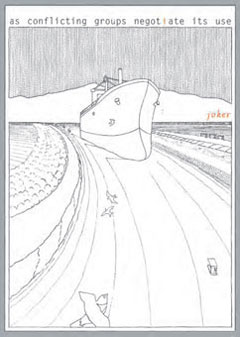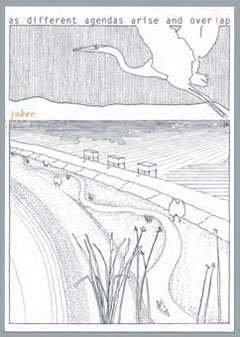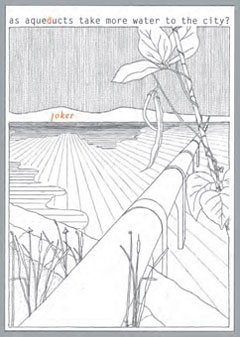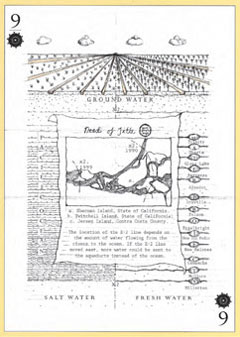Delta Primer: A Field Guide to the California Delta
page 1
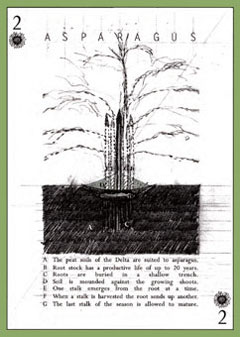 |
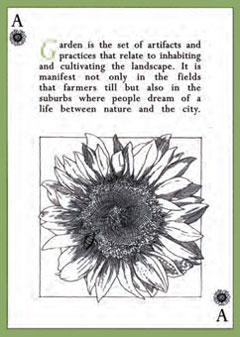 |
The California Delta, a nexus of agricultural and urban development, is now the most contested landscape and watershed systems in California. Once marshland long ago drained for farming, the system has become the protected habitat for endangered species, including the Delta Smelt. The Delta's water is what transforms California's semi-desert into Shangri-La.
Wolff's Delta Primer is a deck of cards, meant to teach us about the landscape and contextualize our understanding of it. The four suits, shuffled (a garden, a machine, a wilderness, a toy) describe the water system, but also the cultural systems engineering the watersheds we (often unknowingly) occupy.
In his preface, California State Librarian Kevin Starr writes, "Delta Primer is … a toolkit and a kit of parts that represents … a breakthrough in the methodology of environmental science … California has need of the Delta Primer not only for the saving of the Delta itself, but also for the case study that saving the Delta… would offer the rest of the state."
page 3
A Game of Chance
Chance juxtaposition of irreconcilable elements is the logical thread that ties the idea of playing cards to an examination of the process by which the human hand has dealt out complex interventions in this vast natural and constructed area. The delta itself gathers waters from half the state of California before emptying through the funnel-like Carquinez Strait into San Francisco Bay and the Pacific Ocean. But the systems here are so complex, the knowledge so incomplete, and the players often so disconnected from the big picture that the chance readings and incomplete vignettes dealt out in a game of cards are perhaps more effective than any comprehensive explanatory text. In particular, the motif of a card game offers both small, intense insights and illustrates the chance interconnectivity of individual and civic works, natural flows, and catastrophic acts of god. To organize this game, in place of hearts, diamonds, spades and clubs, Wolff gives us the garden suit, the machine suit, the wilderness suit, and the suit of toys — and all the possibilities of jokers wild
"The flooding of the fields masks the difference between the river and the island. When that happens, the levee is the only visible souvenir of reclamation" (page 135, king of wilderness). "The levees were an attempt to create stasis in the landscape: their purpose was to stop seasonal flooding. Instead they just redirected the flux of the river system. Their effects, combined with subsidence, have created a dilemma that cannot be resolved" (page 115, three of wilderness). "The water turned brown with mud. Fish choked and died from lack of oxygen. Stream channels filled with silt. Boat traffic became impossible. Flooding grew worse and worse. The landscape was devastated" (page 129, ten of wilderness).
"All of these interventions are made so that the landscape will be easier to use. Water channels can't move; their banks don't overflow; distances are shorter; navigation is simpler; ownership is clear. The flux of the rivers is arrested, at least for the moment" (page 93, five of machines). "The side draft clamshell dredger was first used in the region in 1879. It won out over competing machines: the dipper dredge, the hydraulic pipeline dredge, and the bucket-ladder dredge. Clamshell dredgers are still used for routine maintenance in the Delta. They do emergency service when a levee breach occurs" (page 91, four of machines). It is not enough to simply marvel at the natural processes; the machines are beautiful, and poetic, too.
"The figures in the map are conjunctions between natural form and human intervention: slips for boats are carved out of small islands, for instance, or the bends in a river are cut by a shipping channel. Finding them is inventing meaning in a series of accidental, uncoded shapes. The products of utility become raw material for daydreams (page 139, two of toys). "Made of off-the-shelf parts and easy to pilot, the Boxie Boat was a houseboat for Everyman" (page 143, four of toys). "The names in the Delta have to do with different things: ownership, location, physical character, use, experience, memory, and wishes. Naming is a way of ordering the world. It makes the landscape into a mirror of experience; sometimes it makes places into poetry" (page 161, king of toys).
"The delta is interesting because it is complicated. The water users are its most powerful constituency. If the landscape remains a blank in their minds, how will they understand the value of other people's demands? The greatest threat to the Delta is its invisibility" (page 169, wild card).
page 6
A Beautiful Layering
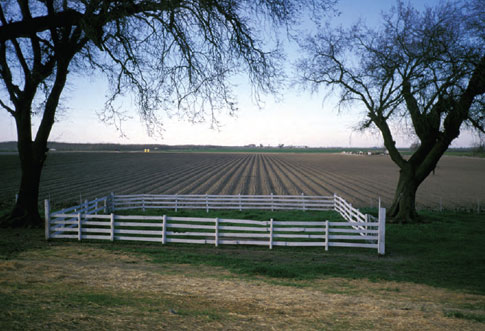
Just as we learn that harvesting the first shoot of an asparagus plant sends out a second shoot, and the cycle continues through the season, a Delta Primer card game will continue to send up small shoots of information as the cards are reshuffled and the play unfolds. Of course, with the asparagus plant you may always expect another asparagus shoot, while this game deals out an endless series of contradictory, yet systemically intertwined, surprises.
The asparagus card reveals a sectional relationship of plant and earth, and a time cycle relationship between nature and human cultivation: "A. The peat soils of the Delta are suited to asparagus. B. Root stock has a productive life of up to 20 years. C. Roots are buried in a shallow trench. D. Soil is mounded against the growing shoots. E. One stalk emerges from the root at a time. F. When a stalk is harvested the root sends up another. G. The last stalk of the season is allowed to mature" (page 61, two of gardens). The best drawings on the cards maintain this rich relationship of multilayered drawing and text, and the side notes in the book offer a little dessert: "Asparagus is harvested by hand. The shoots are cut from below the ground with a special knife, tied into bundles, and collected in small carts." None of this would make it into a conventional exposition on a great river system with immense economic and environmental consequence. The knowledge and idea bits offered in the cards may add up to a more complex reading of a complicated landscape involving not just the abstract forces of nature and machines, but also of the intertwining beauty of chance collisions, benign and catastrophic. Flying over the delta, one reads the beautiful layering of natural flows and human ordering, construction and cultivation. At this height, the landscape becomes a fantastic painting projecting the complementary accomplishments of nature and civilization. Closer to the ground, the wonders of nature still exist, yet one also finds oneself caught by a wary attraction to the ingenious machinery of farming, mud-dragging, mining and transportation. But much ugliness, and greed, and thoughtlessness become evident as well, and there are vague insinuations of larger calamities that lie in wait. Jane Wolff's book and deck of cards deal out all of these sensations and understandings, and package them in a realistically unsettling context of chance and uncertainty.
If there is one problematic aspect to this production it is that the reproductions of drawings and maps in the book are too small to provide a generous reading beyond the more dynamic experience and logic of the cards. While the best drawings offer the greater power of richly layered and integrated drawing and text, in some cases the drawings become mere illustrations, and the text becomes mere caption. Despite these few reservations, one appreciates the wide-ranging insights and ideas, and their deceptively simple presentation. But the experience is most powerful after one has spent a little time shuffling the cards, and dipping erratically through the pages of the book. This is an unexpectedly subtle, sympathetic and approachable introduction to a complex and beguiling landscape that holds terrifying implications for a complicated and populous state.
A pretty deck of playing cards offering a good time and a painless education may be an ingenious way for Jane Wolff to make the delta visible to its enormous public constituency: "The greatest threat to the delta is its invisibility" (page 169 again, wild card).
RELATED PLACES San Joaquin Delta





